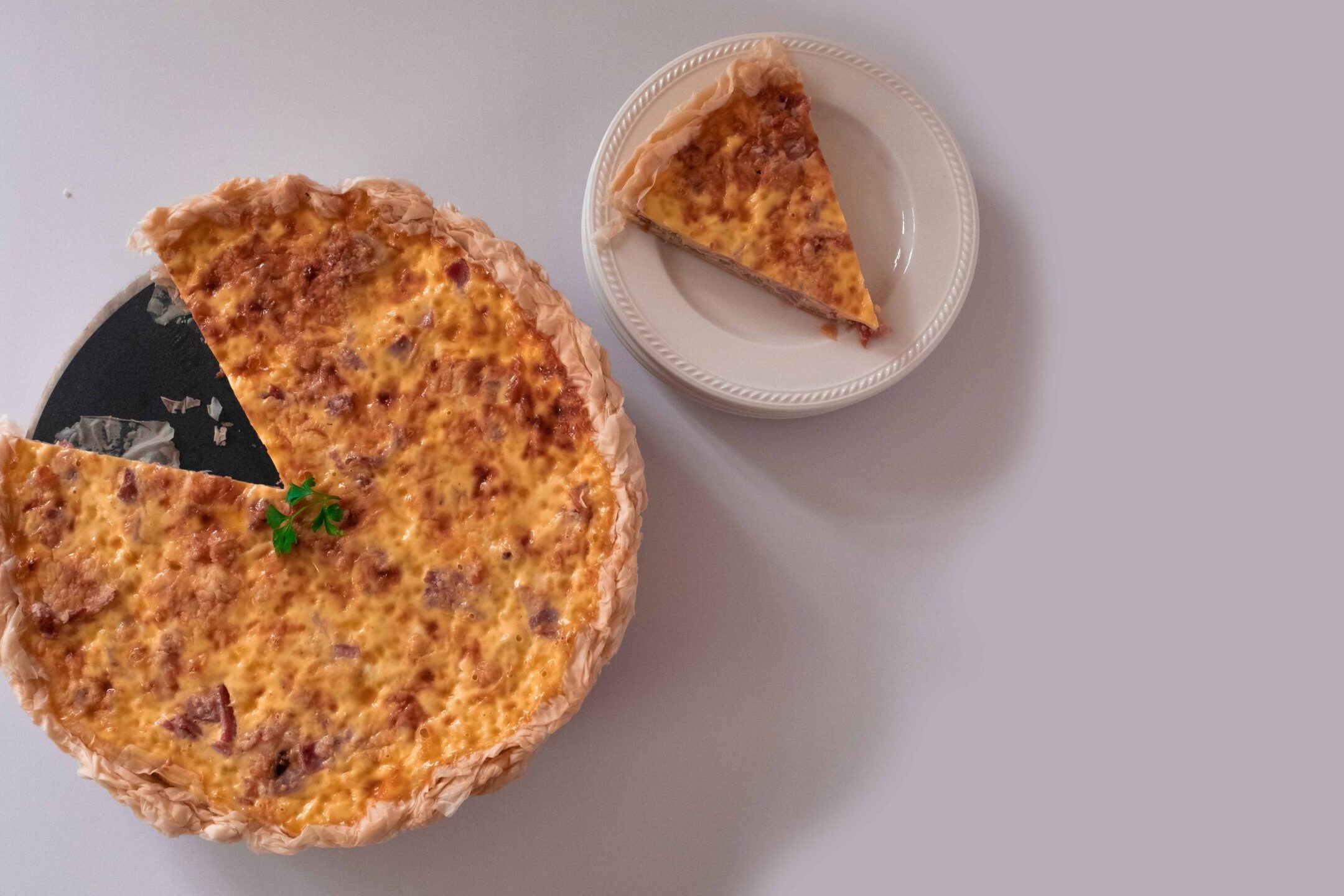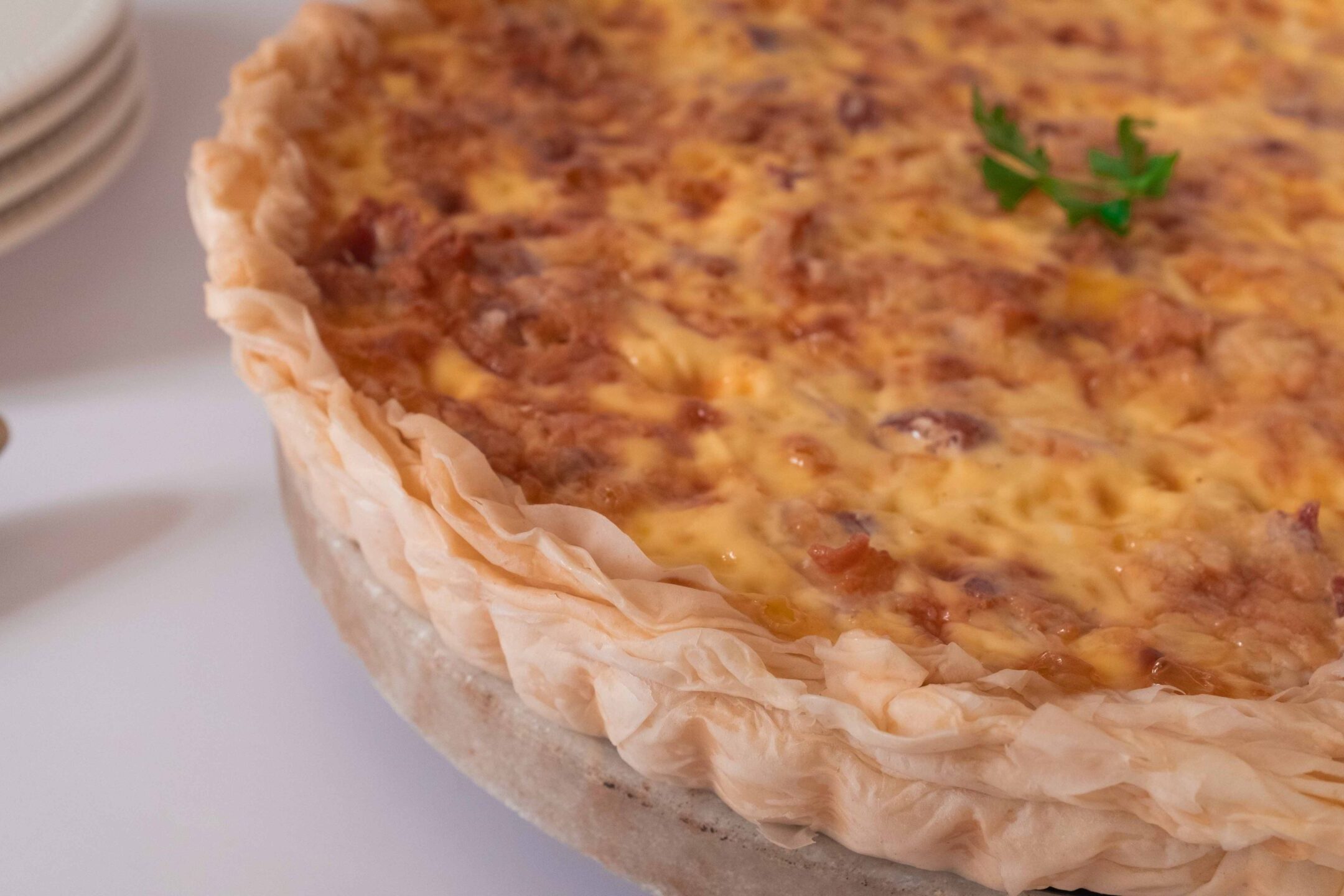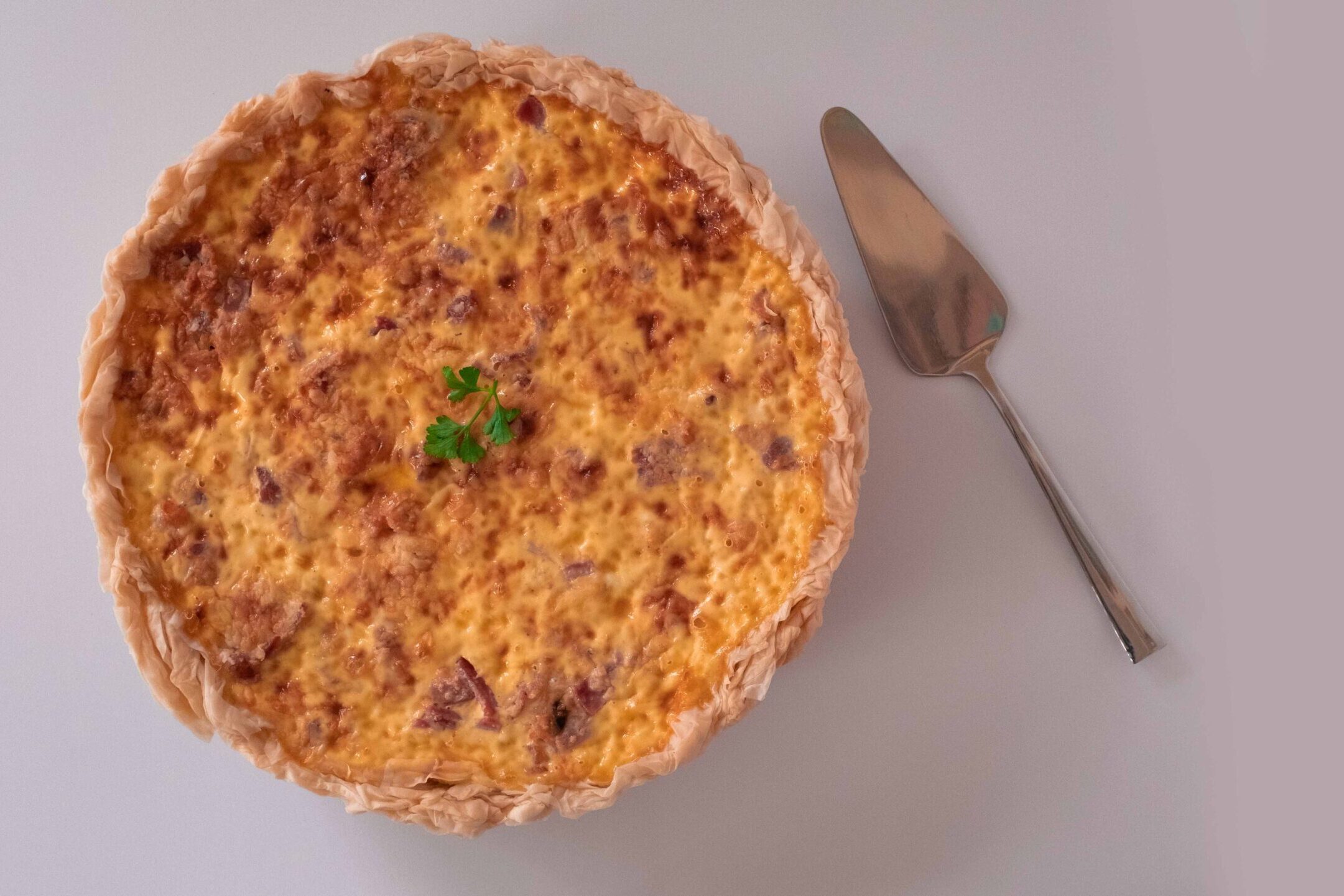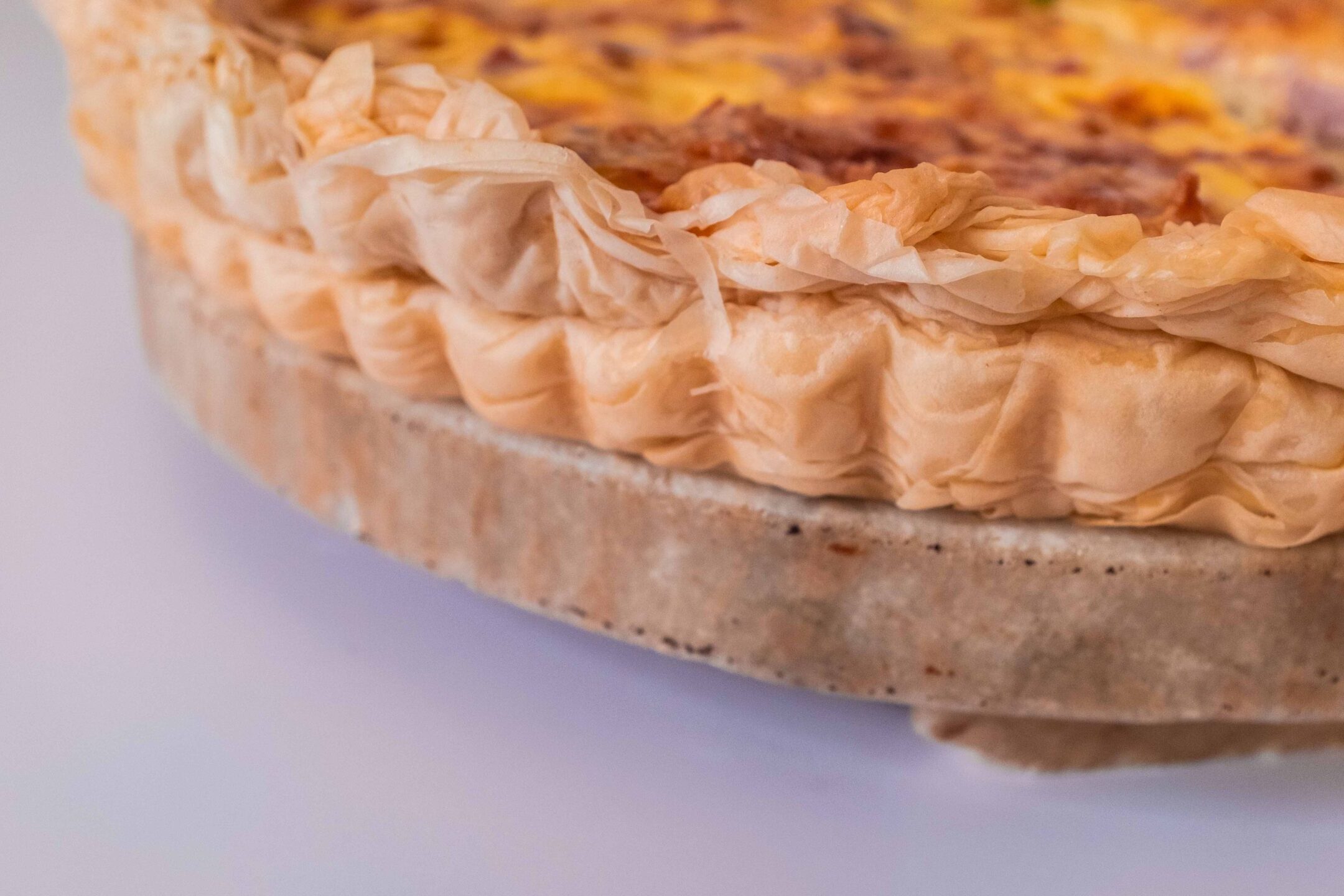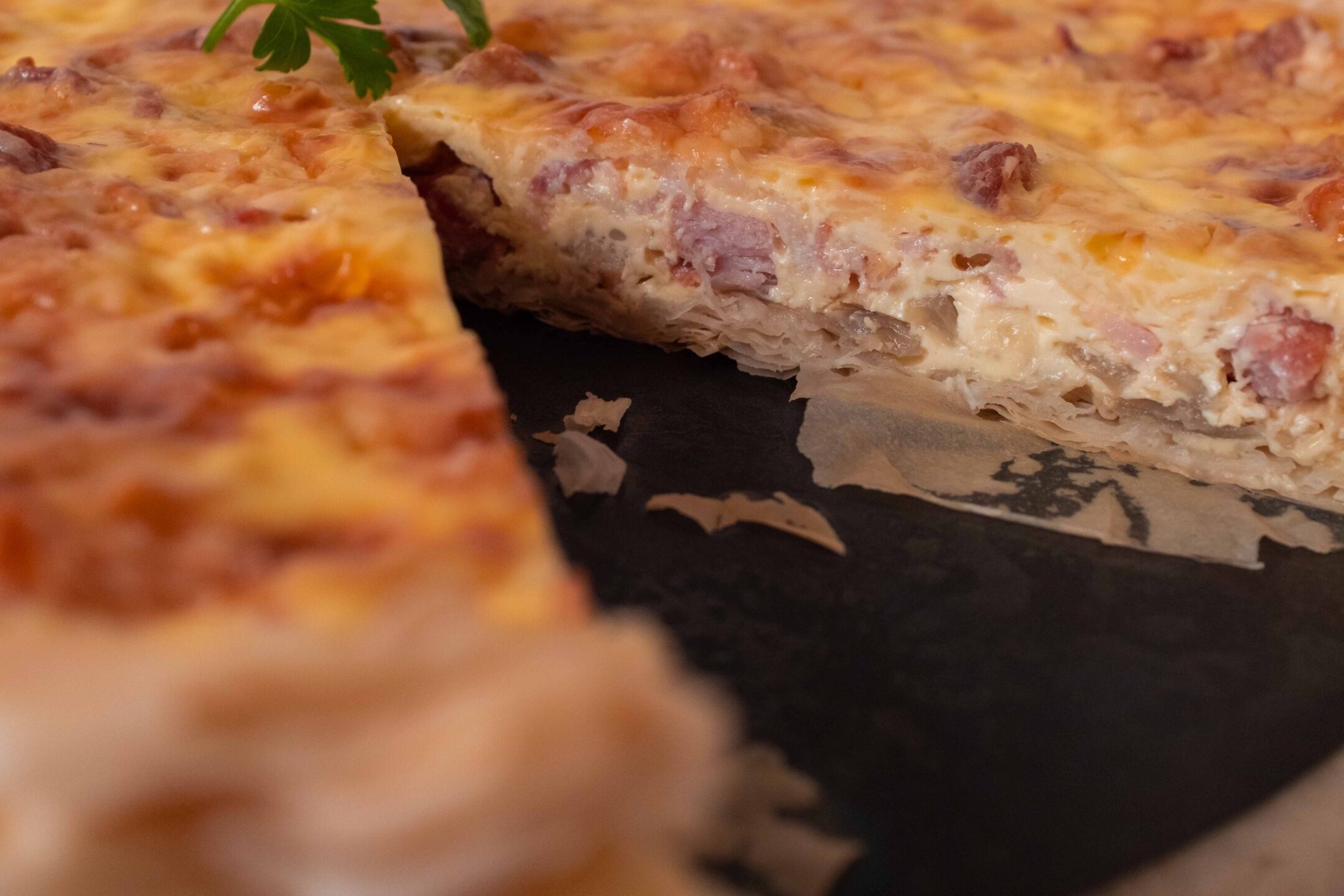Makes one 11 inch quiche.
Last year, I had the privilege of eating Quiche Lorraine, in Lorraine. Cream, eggs, bacon, pastry. That’s it. Yet, it was so profoundly delicious, that I had to recreate it in Mumbai. My recipe has the basic flavour profile of a traditional Quiche Lorraine, with one major modification—a phyllo pastry base. What results is a light as air, crispy crust that tastes phenomenal and is a lot easier to make than shortcrust pastry. Plus, you won’t feel quite as bad when you devour an 11 inch quiche in one sitting.
At a glance
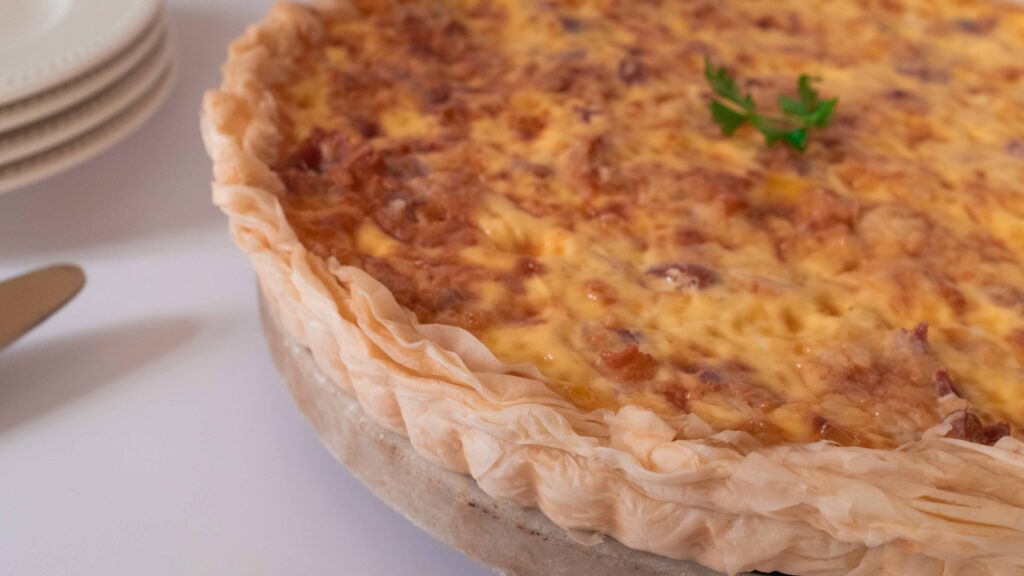
– This recipe comprises fried yummy bits + phyllo pastry base + savoury custard filling.
– You will need an 11 inch quiche pan with a removable base.
– This recipe has been broken into 4 stages for ease and comprehension. Please read the entire recipe from start to finish before beginning.
Stage 1: fried yummy bits
Ingredients
1. 1 large onion, finely diced
2. 200 gm lean bacon cut into ¼ x 1 inch strips
3. 200 gm streaky bacon cut into ½ x 1 inch strips
Method
1 – Put the chopped onions and streaky bacon in a cold pan and then place it over low-medium heat.
2 – Once the fat from the streaky bacon starts to render and the meat begins to sizzle, add the lean bacon chunks to the pan.
3 – Fry everything on medium heat for approximately 4 minutes. The bacon will be cooked and the onions should be softened, but not browned. Remove everything from the pan with a slotted spoon and leave it aside to cool to room temperature. Reserve the leftover bacon fat for a later date.
A traditional Quiche Lorraine uses “lardons”, which isn’t readily available where I live. If you can get your hands on slab bacon, you can cut your own lardons. You could even use a mix of streaky bacon and pancetta. I did an equal mix of lean and streaky bacon for equal parts meatiness and fattiness. Onions are not traditional to Quiche Lorraine, but I like the sweetness they bring to the dish.
Stage 2: phyllo pastry base
Ingredients
1. 10 phyllo pastry sheets
2. 60 gm unsalted butter, melted and cooled
Method
1 – Cut your phyllo sheets into 12 inch squares.
2 – Using a pastry brush, grease your quiche pan with melted butter.
3 – Take one sheet and brush it all over with some melted butter. Lay the sheet, butter side up, into your quiche pan. The extra phyllo will hang over the sides of the pan.
4 – Brush melted butter on another sheet of phyllo and, lay it slightly askew on top of the first sheet, so that the corners of the two sheets are not lined up. Repeat this process till all 10 sheets are buttered and stacked on top of each other in overlapping squares. The finished base should remind you of a sunflower with multiple ‘“petals”; read corners’ poking out from around pan’s entire circumference. Remember to gently press each sheet into the base and sides of the pan before layering on the next sheet. You want a packed base with no large air pockets between each layer.
5 – Fold, crimp, and scrunch the overhanging bits of phyllo back over the sides of the quiche pan and press it into the sides. This will form a raised, ruffled crust. Don’t worry about being refined. Rough and rustic means a crispier phyllo. Cover the entire pan with a damp cloth while you get started on Stage 3.
So, this is the biggest departure from an authentic Quiche Lorraine, which has shortcrust pastry as its base. I was not going to make shortcrust pastry in hot weather, so I thought I’d try ready-made phyllo pastry instead. Raw phyllo is stored in the freezer. Before it can be used, it must be thawed in the fridge overnight. If you put it on your counter straight from the freezer, it will thaw too quickly, get wet and mushy, and tear easily. Whenever you’re working on one phyllo sheet, be sure to cover all the others with a damp towel. This will prevent them from drying out and getting brittle. As long as these basics are kept in mind, phyllo is a lot easier to work with, any time of the year. Best of all, no blind-baking!
Stage 3: savoury custard mixture
Ingredients
1. 300ml heavy cream (full fat)
2. 5 large eggs (total mass = 285 gm)
3. ½ tsp freshly grated nutmeg
4. Generous pinch of salt
5. ½ tsp white pepper powder
Method
1 – Whisk together the eggs and heavy cream, till well combined.
2 – Season the mixture with salt, white pepper, and nutmeg. Keep this aside momentarily.
3 – Set your oven to preheat at 180OC and immediately begin Stage 5.
Stage 4: Finale; assembly and baking
Components
1. Fried yummy bits (no longer hot)
2. 100 gm grated Gruyère
3. Layered phyllo pastry base in quiche pan
4. Savoury custard mixture
Cheese doesn’t go into a traditional Quiche Lorraine. However, if you do add cheese, go with a mild, nutty Swiss cheese that balances the salty notes of the bacon rather than overpowers it with its own strong flavour.
Method
1 – Evenly sprinkle the grated Gruyère into you prepared phyllo pastry base.
2 – Scatter the fried onions and bacon bits on top of the cheese.
3 – Give your savoury custard mixture a final stir and gently pour it over the bacon, onions, and cheese.
4 – Bake your quiche at 180OC for 35-40 minutes, or until the pastry is golden and crispy, the quiche is lightly browned on top, the sides are set, and the centre is still a bit jiggly. Keep an eye on it so that it doesn’t overbake! It should have the texture and taste of a set custard and not a well-done omelette.
5 – Remove it from the oven. This version of Quiche Lorraine tastes best when eaten fresh, but you’ll need to cool it on a wire rack for 15 minutes to let it set before slicing into it.
6 – In the 15 minutes you have to spare, whip up a fresh, simple salad. Throw together some roquette leaves, sliced cherry tomatoes, walnut kernels, and apple slices. Toss it all with a good glug of balsamic vinegar and olive oil. Season with salt and pepper. Done.
7 – It’s time to slice into that quiche! Remove it from the pan, cut it into wedges and serve it warm, with your fresh salad on the side.
Food purists might balk at my use of phyllo, but we love the light, crispy base that accompanies this version of the classic. I will concede; it’s not a Quiche Lorraine, it’s Quiche Lorraine…ish. And a way for us in hot and humid India to turn our homes into French bistros for a day. If you do decide to make a phyllo base, remember, cooked phyllo pastry gets soggy and leathery when it’s refrigerated or left to sit out. Leftovers need to be reheated slowly in the oven to crisp up the base again. 150OC for 30-40 minutes should do it.

